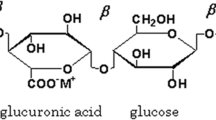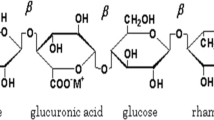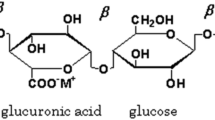Abstract
A new class of environmental friendly bio-based electrolytes has been synthesized from natural tree gum of Moringa oleifera by solution casting technique. An ionic salt of ammonium nitrate (NH4NO3) of varying compositions from 0.2 to 0.6 wt % has been used as an additive to optimize the ionic conductivity of Moringa gum (MG) based biopolymer membranes. X-ray diffractograms affirm the enhancement in amorphous nature of the membranes with the addition of salt, and the high degree of amorphous nature is exhibited by the composition of MG (1 g) with 0.5 wt % NH4NO3. Complex formation between MG and salt has been studied by Fourier transform infra-red (FTIR). Thermal behavioural study by differential scanning calorimetry (DSC) authenticates the flexibility of the prepared MG-based membrane with NH4NO3 by low glass transition temperature. The obtained solid polymer electrolyte MG (1 g) with 0.5 wt % NH4NO3 achieved an ionic conductivity as high as 2.66 × 10−3 S cm−1 at room temperature and the high ionic transference number of 0.98 is observed for the same. Primary proton cell has been fabricated with the optimum conducting polymer membrane (with a configuration Zn: ZnSO4.7H2O:C|| MG :0.5 wt % NH4NO3 Membrane || PbO2: V2O5 ) exhibits an open cell potential of 2.19 V and 1.88 V when shunted through the load resistance of 100 KΩ. Natural tree gum of Moringa oleifera as an electrolyte in the primary proton cell has provided a considerable open cell potential of 2.19 V which authenticates the utility of MG as a successful electrolytic material.










Similar content being viewed by others
References
Rayung M, Aung MM, Azhar SC, Abdullah LC, rSu’ait MS, Ahmad A, Jamil SNAM (2020) Bio-based polymer electrolytes for electrochemical devices: insight into the ionic conductivity performance. Materials 13:838. https://doi.org/10.3390/ma13040838
Kadir MFZ, Majid SR, Arof AK (2010) Plasticized chitosan–PVA blend polymer electrolyte based proton battery. Electrochim Acta 55(2010):1475–1482
Teoh KH, Lim C-S, Ramesh S (2014) Lithium ion conduction in corn starch based solid polymer electrolytes. Measurement 48:87–95
Mendes J, Esperanca JMSS, Medeiros MJ, Pawlicka A, Silva MM (2017) Structural, morphological, ionic conductivity, and thermal properties of pectin-based polymer electrolytes. Mol cryst liq cryst 643(1):266–273
Monisha S, Mathavan T, Selvasekarapandian S, Milton Franklin Benial A, Aristatil G, Mani N, Premalatha M, Vinoth pandi D (2017) Investigation of bio polymer electrolyte based on cellulose acetate-ammonium nitrate for potential use in electrochemical devices. Carbohydr Polym 157:38–47
Chitra R, Sathya P, Selvasekarapandian S, Meyvel S (2019) Synthesis and characterization of iota-carrageenan biopolymer electrolyte with lithium perchlorate and succinonitrile (plasticizer). Polym Bull 77(6):1555–1579
Mary A, Selvanayagam S, Selvasekarapandian S, Chitra R, Leena chandra M V and Ponraj T, (2020) Lithium ion conducting biopolymer membrane based on K-carrageenan with LiNO3. Ionics 26(9):4311–4326
Rimpy A, Ahuja M (2017) Evaluation of carboxymethyl moringa gum as nanometric carrier. Carbohyd Polym 174:896–903
Gupta S, Kachhwaha S, Kothari SL, Bohra ManojKumar, Jain R (2020) Surface morphology and physicochemical characterization of thermostable moringa gum: a potential pharmaceutical excipient. ACS Omega 5(45):29189–32919
Panda DS, Choudhury NSK, Yedukondalu M, Si S, Gupta R (2008) Evaluation of gum of moringa oleifera as a binder and release retardant in tablet formulation Indian journal of. Pharm Sci 70(5):614–618
Subha V, Ramadoss P, Renganathan S (2016) Incorporation of biotransformed silver nanoparticles in plant polysaccarides resin and their effect on sustained drug release. Polym Sci Ser B 58(1):61–72. https://doi.org/10.1134/S1560090416010073
Abhishek R, Ahuja M (2018) Moringa gum-g-poly(N-vinyl-2-pyrrolidone) – a potential buccoadhesive polymer. Int J Biol Macromol 109:732–739
Boopathi G, Pugalendhi S, Selvasekarapandian S, Premalatha M, Monisha S, Aristatil G (2016) Development of proton conducting biopolymer membrane based on agar–agar for fuel cell. Ionics 23:2781–2790. https://doi.org/10.1007/s11581-016-1876-x
Ng LS, Mohamad, AA (2006) Protonic battery based on a plasticized chitosan-NH4NO3 solid polymer electrolyte. J Power Sour 163(1):382–385
Hafiza MN, Isa MIN (2017) Solid polymer electrolyte production from 2-hydroxyethyl cellulose: effect of ammonium nitrate composition on its structural properties. Carbohydr Polym 165:123–131. https://doi.org/10.1016/j.carbpol.2017.02.033
Isa MINM, Rani MSA, Mohamed NS (2015) Investigation of the ionic conduction mechanism in carboxymethyl cellulose/chitosan biopolymer blend electrolyte impregnated with ammonium nitrate. Int J Polym Anal Charact 20(6):491–503
Bhuvaneswari R, Karthikeyan S, Selvasekarapandian S, Vinoth Pandi D, Arun VN, Araichimani SC (2014) Preparation and characterization of PVA complexed with amino acid, proline. Ionics 21:387–399. https://doi.org/10.1007/s11581-014-1206-0
Alves R, Sentanin F, Sabadini RC, Fernandes M, de Zea BV, Pawlicka A, Silva MM (2018) Samarium (III) triflate-doped chitosan electrolyte for solid state electrochromic devices. Electrchim Acta 267:51–62
Al-Gunaid MQA, Saeed AMN, Siddaramaiah, (2017) Effects of the electrolyte content on the electrical permittivity, thermal stability and optical dispersion of poly (vinyl alcohol)-cesium copper oxide-lithium perchlorate nanocomposite solid-polymer electrolytes. J Appl Polym Sci 135:45852. https://doi.org/10.1002/app.45852
Mehetre G, Pande V, Kendre P (2015) Isolation and characterization of bionanofibers from moringa oleifera gum as a platform for drug delivery. Nanosci Nanotechnol Res 3(1):1–5
Singh B, Kumar A (2020) Exploration of arabinogalactan of gum polysaccharide potential in hydrogel formation and controlled drug delivery applications. Int J Biol Macromol 147:482–492
Manjunathaa V, Subramanyaa K, Devendrappaa H (2014) Structural optical and electrical conductivity properties of Li2SO4 doped polymer electrolytes. Compos Interfaces 21(2):121–131
Ahmad S, Manzoor K, Purwar R, Ikram S (2020) Morphological and swelling potential evaluation of moringa oleifera gum/poly(vinyl alcohol) hydrogels as a superabsorbent. ACS Omega. https://doi.org/10.1021/acsomega.0c01023
Ranote S, Kumar D, Kumari S, Kumar R, Chauhan GS, Joshi V (2019) Green synthesis of moringa oleifera gum-based bifunctional polyurethane foam braced with ash for rapid and efficient dye removal. Chem Eng J 361:1586–1596
Fuzlin AF, Saadiah MA, Yao Y, Nagao Y, Samsudin AS (2020) Enhancing proton conductivity of sodium alginate doped with glycolic acid in bio-based polymer electrolytes system. J Polym Res 27:207. https://doi.org/10.1007/s10965-020-02142-0
Taib NU, Idris NH (2014) Plastic crystal-solid biopolymer electrolytes for rechargeable lithium batteries. J Memb Sci. 468:149–154. https://doi.org/10.1016/J.Memsci.2014.06.001
Ramlli MA, Isa MIN (2016) Structural and ionic transport properties of protonic conducting solid biopolymer electrolytes based on carboxymethyl cellulose doped ammonium fluoride. J Phys Chem B 120(44):11567–11573
Funding
The authors have not received special grant from any funding agency for this work
Author information
Authors and Affiliations
Corresponding author
Ethics declarations
Conflict of interest
Authors have no conflict of interest
Additional information
Publisher's Note
Springer Nature remains neutral with regard to jurisdictional claims in published maps and institutional affiliations.
Rights and permissions
About this article
Cite this article
Chitra, R., Krishna, M.V. & Selvasekarapandian, S. Study on novel biopolymer electrolyte Moringa oleifera gum with ammonium nitrate. Polym. Bull. 79, 3555–3572 (2022). https://doi.org/10.1007/s00289-021-03676-z
Received:
Revised:
Accepted:
Published:
Issue Date:
DOI: https://doi.org/10.1007/s00289-021-03676-z




